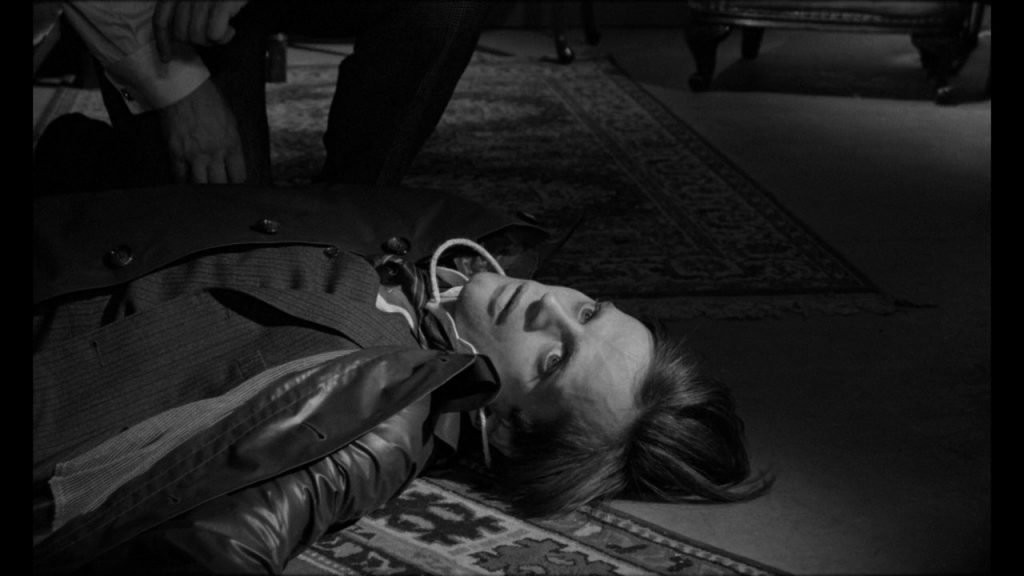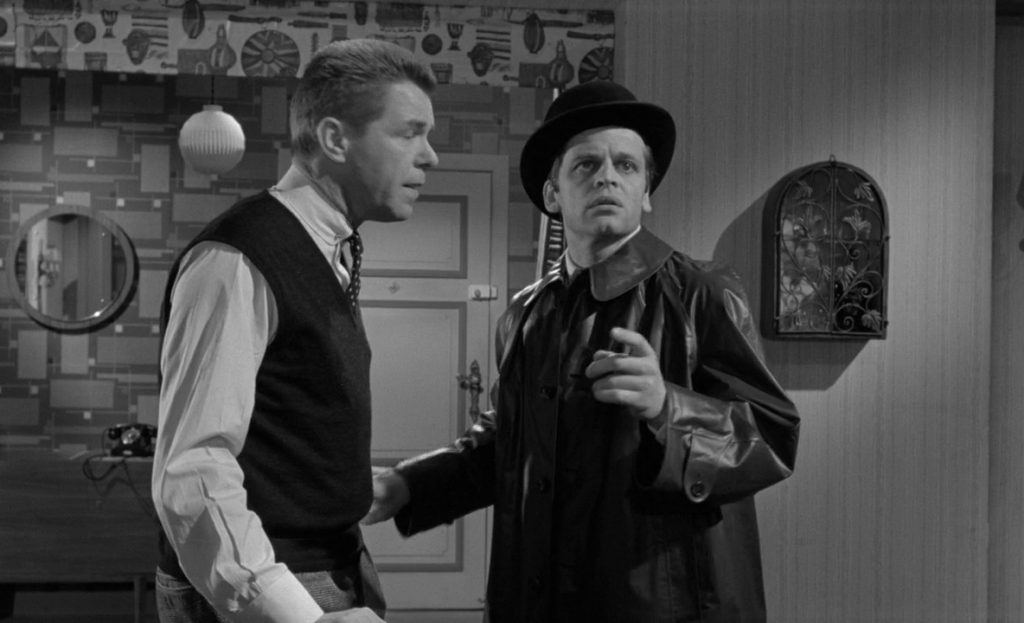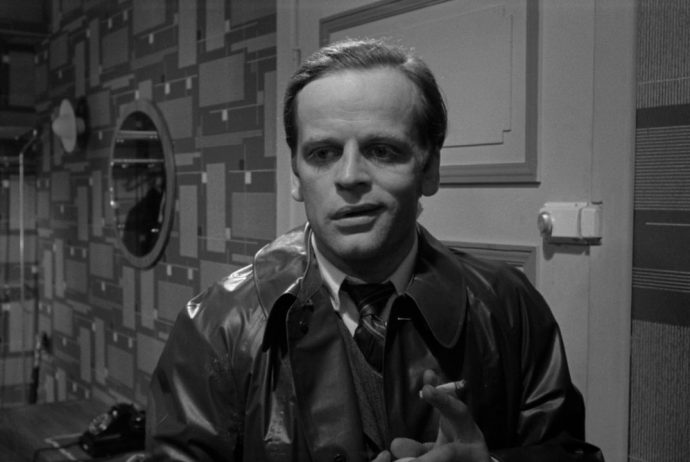Dir: Alfred Vohrer
Star: Heinz Drache, Sabine Sesselmann, Hans Nielsen, Klaus Kinski
a.k.a. Chamber of Horrors
This early krimi feels like a precursor to some of the later Kinski roles we’ve reviewed recently, e.g. The Soldier. It’s a very brief role: he collects his check about the fifteen minute mark. Yet it’s one where he still manages to make an impression. The main difference is, I suspect, that at this point in his career, he was probably happy simply to get the work, especially given the recent birth of his first daughter, Nastassja, for whom Klaus now had to provide. While this film is not mentioned by name in All I Need is Love, there is this passage from around the period.
For a while I shoot most of my films for Rialto-Constantin. When I need more money and ask the shithead for a bigger advance, he says, “Of course, my boy, come to my office tomorrow.”When I get to his office he has a contract for five more films prepared, which he lays before me for signature before he’ll give me the promised advance. So I’ve sold myself for another year. I have no idea what I’ve signed. I have to take on any shit. As I’ve said, it’s all the same to me.
All I Need is Love, pp 142
Still, I have to say I quite enjoyed this one. The focus is an apparently unconnected pair of murders in London, where it’s eventually realized the victims were both carrying almost matching keys. Inspector Dick Martin (Drache) investigates the cases, and finds a letter to the attorney Haveloc (Nielsen), who is the executor for the estate of the late Lord Selford. The heir apparent, currently living a raucous lifestyle on the continent, is about to return to Britain, in order to come into his inheritance, which has been held in trust. It appears his father sent seven associates a key which, together, will open a door in the family crypt on that day.
Clearly, one or more people have a vested interest in preventing that from happening. As well as Haveloc, possible candidates to fall into police interest include (but are not limited to): former employees Mr. and Mrs. Cody; their butler with a criminal past, Tom Cawley; impoverished niece, now working as a librarian, Sybil Lansdown (Sesselmann); and Dr. Antonio Staletti, a disgraced scientist who has set up his operation at Selford Manor. It is up to Martin, along with his plucky sidekick Holmes (series regular Eddie Arendt) – and, yes, they do go there! – to fend off attempts on their lives and figure out who is/are the guilty party or parties.
Although it turns out the murder are not actually the only nefarious deeds going on. For Staletti has grown fed up of experimenting on animals, and has turned his attention towards more human subjects. His first didn’t quite turn out as intended, becoming a mute child-like hulking brute (played by Austrian pro wrestler Ady Berber, in a very Tor Johnson-esque performance – he has a similar role in The Dead Eyes of London). But, if at first you don’t succeed… All the mad doctor needs is an appropriate candidate for the pituitary gland surgery, in his basement dungeon. Where there’s a large ape kept in a cage, because why not.

For once, Kinski is not one of the potential candidates under suspicion. As noted, he checks out rather quickly. Indeed, he appears in the first scene after the opening sequence depicting a murder at Victoria Station. The safe-cracker he plays, Pheely, is banging on the door of Inspector Martin’s apartment, offering to trade information in exchange for security. He was commissioned to crack the seven locks on the door, but got cold feet after suspecting that he wouldn’t be allowed to live and see what was beyond the portal. He’s now willing to tell everything he knows to Martin in exchange for protection, but the detective gets called in to Scotland Yard.
Naturally, by the time Martin returns to his apartment that night, Pheely has been silenced. The corpse is stuffed into a wardrobe, from where he slumps when his host opens the door. From the point of view of the Kinski fan, this is a decent scenario, given the relatively small role. He shows up early, has a good scene, then becomes a corpse in no uncertain manner, meaning we can simply relax and enjoy whatever pleasures the rest of the film has to offer. Which are quite adequate, Martin providing a quirky hero with a fondness for magic, using sleight of hand to pull a cigarette, lighter and even an egg out of a bemused Pheely’s ear during their conversation.
This was the second adaptation of the Edgar Wallace novel, published in 1926. There had previously been a British film, The Door With Seven Locks, directed by Norman Lee in 1940, with Romilly Lunge in the role of Inspector Martin, with Lilli Palmer (a future Mrs. Rex Harrison) as Ms. Lansdowne. I haven’t see it, but sense this is a bit more lurid. One German site called it, “probably one of the trashiest Rialto thrillers,” though you’d never get me to admit that was a bad thing! Production on this was delayed so that the script, which was originally considerably more globe-trotting, could be pared down to a level consistent with the available budget.
I do feel the mad scientist angle feels rather bolted on and superfluous, though did appreciate the mention of Soviet experiments in head transplantation (credited here to a Dr. Pavlov, when it was actually Dr. Vladimir Demikhov). There’s plenty going on in the main body of the plot as it is, and the horror element it provides, seems at odds with the more prosaic motives of the other characters. I’m also not quite sure the logic stands up to scrutiny, with the bad guys possessing knowledge far in excess of what they plausibly should e.g. how did they know Pheely had gone to see Inspector Martin?
Still, I can’t argue I was not entertained: it’s full of interesting characters, and the plot keeps moving on, without significant dead spots. Any weaknesses certainly didn’t stop the film from being a roaring success. It sold over three million tickets in Germany to put it among the top half-dozen of Wallace adaptations. The krimi gravy train was well under way, and as we found out earlier, Klaus was apparently inked in for a number more stops.

